android ios app launch page design
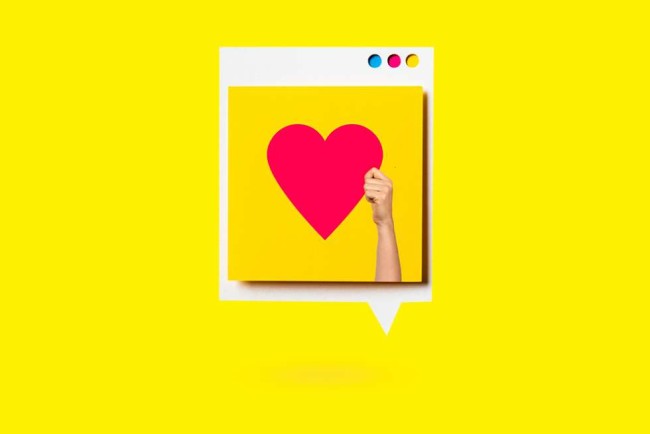
When it comes to user behavior, details matter: simply making calls-to-action more prominent can increase conversions by almost 600%!
Adding reviews boosts conversion by another 35%.
These are just some of the examples of how good design can improve your app landing page performance.
In this article we will discuss:
- What an app landing page is why having one is important for your business
- 10 examples of amazing app landing pages that have high conversion rates + takeaways on what makes them great
- How to create and optimize the app landing page
- The 5 essential elements every app landing page should have
Let's get to it!
What Is An App Landing Page?
App landing pages are web pages designed to promote your mobile application and drive downloads.
Whether through a marketing campaign and/or organic search traffic, this is where your leads will land to get more information about your app and to download it.
These landing pages usually contain the app's description, features and value propositions. They also utilize call-to-action buttons and links to drive conversions.
The Benefits Of A Well-Designed App Landing Page
If you host the app landing page on your business' website, this will increase online traffic and potentially lead to greater brand visibility, trust, lead retention and profit.
Landing pages can:
- Support your brand's business objectives: App landing pages promote new products. Their goal is to attract new customers and boost conversions, which in this case are app downloads. Landing pages can easily measure the success of business strategies, as well.
- Generate high-value leads: Landing pages have a single focus objective and one call-to-action – to get people to convert; in this instance, to download the app. As opposed to people who may end up on your site's homepage, the prospects who have come to the app landing page are high-value leads because they are looking for a particular value that your app can provide.
- Improve conversion rates: Well-designed app landing pages with a clearly defined conversion funnel increase on-page engagement and conversions.
- Better brand awareness: By collecting marketing campaign leads, app landing pages are a great way to promote your brand and funnel some of that traffic further through your website (if you offer more than the app, that is).
- Bigger brand credibility: Apps without landing pages miss out on the opportunity to give users more information and build trust – important prerequisites for conversions.
A pro tip that provides another benefit: Consider creating the so-called "pre-launch landing page" before your app goes live. This can help you generate buzz and pre-signups.
Agency description goes here
Agency description goes here
Agency description goes here
App Landing Page Inspiration: 10 Great Examples Of App Web Pages That Convert
These 10 app landing page examples show mastery of branding, design and strategy.
1. Siftnewstherapy

What it is: Mobile app that filters out news according to the user's affinities to reduce stress and anxiety.
What this landing page has: Custom illustrations and muted colors that convey the sense of calm, supporting the app's main purpose.
The page contains several components:
- The sticky navigation header with a CTA and useful FAQ section
- Hero section with the slogan "Feel news differently", brief explanation of the app and a call-to-action
- The section that outlines users' pain points
- The timeline that showcases how the app works and what the end results are
- Features and a footer section that repeats the CTA button
What we can learn from it: A natural flow of the page reflects the way in which it should inform the prospect about the ways this app can help them reduce anxiety.
A particularly effective is the use of a Timeline-like layout of the section that provides value propositions and explains the app's functionalities.
2. Thrive
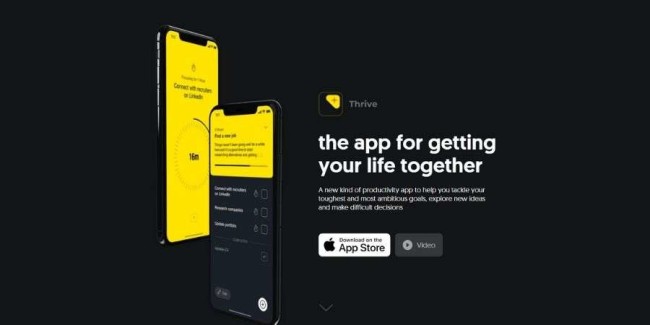
What it is: An app for enhancing and focusing user's work productivity and helping them make a difficult job and career-related decisions.
What this landing page has: A very thorough process of educating the prospects begins with a hero image of app in action as well a brief description of what it does. A CTA is the App Store download button, next to which is a link to an explanatory video.
Awards and recognition badges that provide the social proof for the app's value follow. The features section is accompanied by the extensive FAQ section that answers users' main pain points.
What we can learn from it: Most app pages use the white space to enhance their content and unique propositions. Thrive landing page embraces this minimalism, but in dark mode.
The luminous yellow, teal and lime accents in app's screenshots create a striking contrast that focus the reader's gaze on the important value propositions and features.
3. Carly
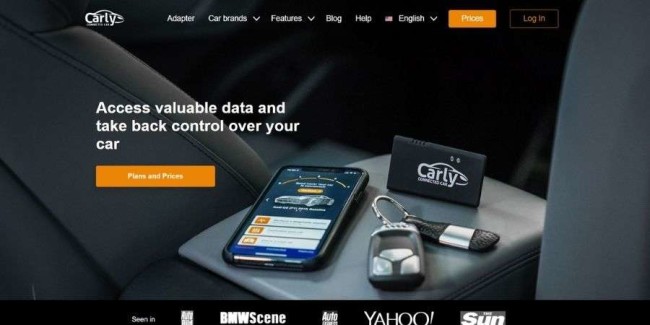
What it is: The app that unlocks users' car's potential by collecting valuable insight into car's health and other properties useful for better maintenance and customization.
What this landing page has: A sophisticated tool like Carly promises a diverse set of outcomes depending on the user's car and needs. This is why the page funnels potential customers into the appropriate checkout flow.
The page opens with a clear value proposition and a CTA, followed by social proof like the list of clients using it and client testimonials.
As they move down the page, users can find the list of benefits, more value propositions and explanations of how the app works and what features it has.
What we can learn from it: While having one singular CTA is always going to be the landing page best practice, Carly proves that, depending on the type of app, it can use more than one.
Carly's app landing page has several CTAs. Each targets a prospect depending on the car they drive and clicking on one will take the user to the download page that is right from them.
4. Tapcart
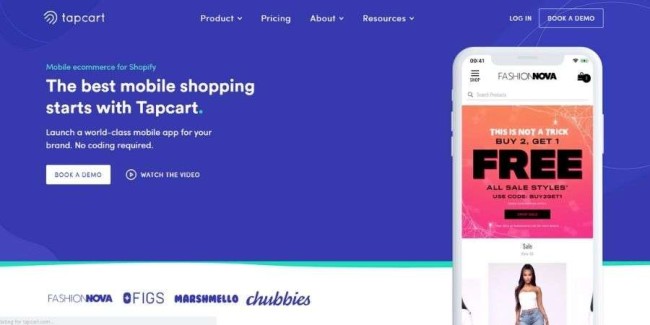
What it is: A mobile app that enhances the online shopping experience by providing push notifications, integrating plugins and optimizing checkout process.
What this landing page has: A great flow of the page leads the user from the main value proposition on the first fold down to the social proof of how many brands use the app, several main benefits, client testimonials, education on its features and ease of use.
What we can learn from it: Tapcart's landing page uses high-quality images, auto-play videos, and GIF animations that show the app in action and its outcomes.
Sections are quite simple and well-structured and the small amount of concise and to-the-point copy make it very easy to understand and digest. CTAs are scattered at the top, middle and bottom of the page.
5. Spendee App

What it is: A mobile and desktop app for managing money and personal funds.
What this landing page has: Using a two-tone layout with white and green, large screenshots of both mobile and desktop variants of the app dominate the hero screen. Next to them is a brief explanation of app's use, "Create a free account" and download buttons.
The awards the app has won and three main value propositions lead the way towards a three-step proposition of the app's use. Several main features follow, as do customer testimonials and press mentions.
What we can learn from it: A mixture of copy, visual elements that help get the point of the app across and a great deal of social proof make this landing page exceptionally well-balanced.
6. BigOven
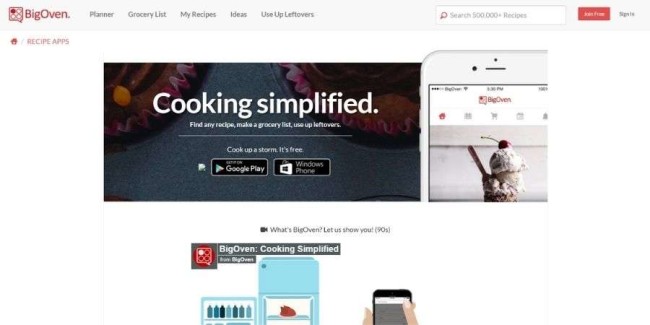
What it is: A mobile app for improving users' cooking skills and finding recipes.
What this landing page has: This landing page uses very much all the pivotal parts of a good app landing page: clear and short copy, CTAs, value propositions and educational/demonstrational content.
Images of the app's layout and design follow the several main points that describe the capabilities of the app.
The central piece, however, is the brief but very educational video that explains the app in-depth.
What we can learn from it: What makes this one stand out is the legible, readable fonts. Headlines and smaller paragraphs are easy to read on mobile devices: titles use large-sized font to make their point extra clear.
The quality of copy lies in more than just typography: the benefits of the app and its unique values are clear to anyone reading only the headers, even without diving into bullet points that follow.
7. Slack
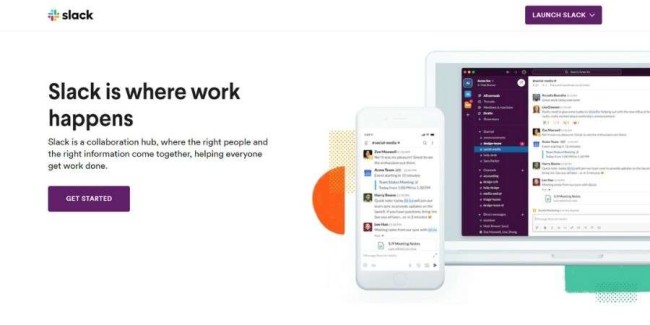
What it is: A messenger tool whose primary use is in business and organizational structures that need to improve their communication workflow.
What this landing page has: Lots of white space to improve visitors' focus on key points, large fonts and legible copy that contains as little words as possible to explain the app.
Slack is very frugal with its value propositions: merely three main points, accompanied by screenshots of app in action, a list of companies that use slack and a "Get Started" CTA that appears at the very top and the very bottom of the page.
What we can learn from it: Slack's landing page explains the app's benefits and features in simple terms. Also, the first fold of the page contains images that showcase the product in its desktop and mobile variants.
To deliver the point clearer and much faster, the page uses icons to demonstrate possible integrations.
8. Keeply

What it is: An app for safe storage of users private files and data.
What this landing page has: Extremely minimalistic and keeping the streamlined single-column flow, Keeply starts out with a screenshot of the app, clear explanation of what it is for and a copy containing key benefits.
As users scroll down and get to know its unique propositions and functionalities, the background color changes, creating a lovely effect and giving each section its distinctive hue.
The CTAs stand at the top of the page, as an AppStore tab to the right and at the footer, as a text link.
What we can learn from it: The original use of background colors allow for a more focused reading. The fonts used are custom and the second half of the page particularly benefits from a very strong and minimal copy.
9. Muzzle
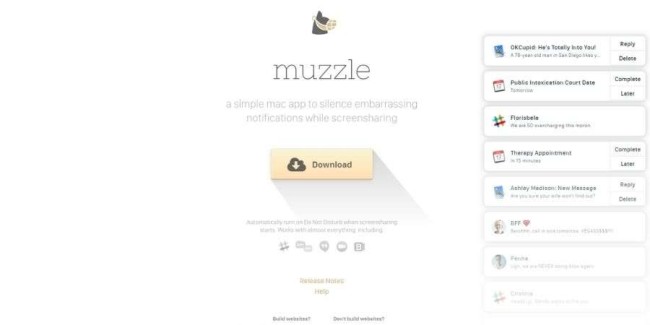
What it is: An app that mutes on-screen push notifications while screensharing, especially suitable for business purposes.
What this landing page has: The immediately eye-grabbing right-hand section that contains hilarious examples of extremely embarrassing notifications that demonstrate all the devastating possibilities if they are seen while screensharing during an online conference.
A very to-the-point explanation of what the app is and what's it for followed by a "Download" CTA. The only remaining element is the showcase of messaging apps it's compatible with.
What we can learn from it: The entire landing page occupies only the first screen of the user - there is no scrolling down. The whole value proposition is remarkably minimal and simple.
This app landing page is fantastically successful in its design because it communicates these value propositions by confronting visitors with the possible pain point the app solves. And it conveys app's use without any copy that describes it!
Also, the uncommon humor factor on landing pages will keep the eyes of the visitors glued to the right section of the page, as examples of embarrassing notifications keep on appearing.
10. Hourly
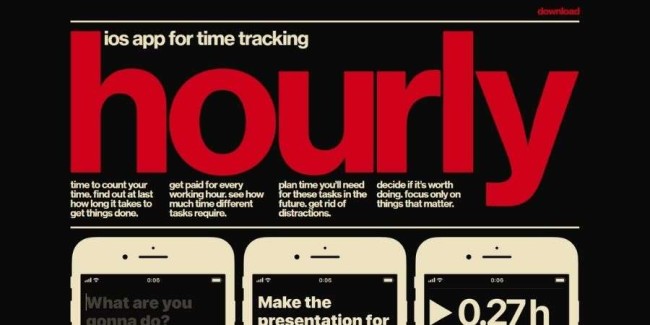
What it is: An iOS-only mobile app for tracking work time.
What this landing page has: This page's radical design mashes its entire content together in a single block containing copy and imagery. And yet, the logic of the user's journey down the page and where their eyes should go is always present.
A descriptive copy is a bit more abundant than previous entries on this list. The text-link CTA appears mid-way and on the bottom of the page. The former employs a neat enlarging effect when a mouse hovers over it.
What we can learn from it: The uniqueness of this app landing page is in its distinctive design.
Dark background, very large headlines in striking sans-serif fonts, condensed content sections and contrasting red and cream colors to accentuate main points create what is possibly the most visually engaging landing page on our list.
Agency description goes here
Agency description goes here
Agency description goes here
5 Must-Have & Edge-Giving App Landing Page Elements That Maximize Conversions
There are certain obligatory elements every app landing page should have in order to increase the chances of educating and, ultimately, converting a prospect.
Looking at the ten examples above, we discovered that there are five must-have elements that, if made properly, lend this decisive edge to app landing pages.
1. Page's Headline
The app landing page's headline should capitalize on the fact that it is the first thing the readers see on the page.
One particular study best explains what's at stakes when it comes to headlines: nine out of ten viewers who read your headline will also read your call to action.
The headline should speak about the value of the app, convey its benefits and drive its selling point home in a concise, economical and effective manner.
It should intrigue the lead to stay on the page and not bounce back immediately and provide the immediate answer to the question of why they may need the app.
2. CTA Button
Call-to-action button, form or text link is the most important app landing page element because it turns leads into customers.
The very reason for landing page's existence is motivating the prospect to move down its funnel and towards call-to-action that converts them.
App landing pages' CTAs should usually point the user to the app store where they can download the app. Alternatively, it may lead to a contact form - once they fill and submit it, they get direct access to the app.
Landing pages should ideally have one dominant CTA - research suggests that but including more than one CTA offer can decrease conversion rates by 266%!
3. Social Proof(s)
Social proof explains the trustworthiness of your app to the visitor.
This can be types of content such as third-party app reviews and existing customers' testimonials have the persuasive power that could nudge the prospect towards the decision to download the app.
Social proofs could also be eventual awards and recognitions the app has won, or the number of total downloads and the number of users.
4. Concise And To-The-Point Copy
The body copy provides an opportunity to elaborate further and in much more depth about your app's value proposition, functionalities and features.
It should expand upon the benefits and answer the users' questions and pain points that you should research and know in advance before making the app landing page.
The copy should satisfy the user that has landed on your app page and prove to them that they were right to have clicked on your page in search results or ad or any other channel they came from.
The type and purpose of the app will determine how much web page copy you should use. For example, a gaming app requires a lot less copy than, say, a fitness app that has multiple functionalities that need explaining.
5. High-Quality Media
Visual elements of the app landing page is what make it stand out from the rest. Image, GIF or video elements provide not only the eye-candy for the page, but can also enhance the point your copy makes.
Each of the five elements listed here should serve a single purpose: emphasize the benefits of the app. The media should also, ideally, showcase the app product in action as well as its distinctive features and stand-out points.
Descriptive copy and prominent use of high-quality media may make your app landing page longer, but don't worry about it: research suggests that longer landing pages can have up to 220% higher conversion rates.

Where Does App Promoting Landing Page Belong In Your Business's Sales Funnel?
As single pages with a highly-defined purpose, app landing pages rely on the information that will motivate visitors to reach the conversion point of the sales funnel.
Due to the multitude of roles they can have, landing pages can belong at any stage of the sales or marketing funnel: top, middle or bottom.
App landing pages can fulfill any of these roles within the sales funnel:
- Conversion of prospects into customers that download the app, sign up or follow the app on social media
- Education of the new traffic that comes from search engines, ads or any other channel
- The motivation of converted customers to promote the app through social shares
- Testing different audience segments through personalized content to determine the piece of text, image or a button that will result in higher conversion rates
The most effective way of using the app landing page within the sales funnel is making it work together with the so-called drip campaigns.
Landing Pages And Drip Marketing
Automated email marketing, or drip marketing, consists of a sequence of targeted emails that are sent when a user takes a certain action like signing up or merely viewing a page.
Marketers use drip marketing to send relevant and personalized emails to their prospects. The automated nature of these email campaigns saves a lot of time and work.
The way landing pages and drip marketing campaigns work together in the sales funnel is this:
The landing page generates leads that are collected as email subscribers. These subscribers enter the segment that launches a series of drip emails whose objective is the conversion of these subscribers into app downloaders.
You can send the users that receive drip emails to a specifically targeted landing page which has the persuasive copy and other elements to help them make a well-informed decision to download the app.
App landing pages and drip email marketing working together can:
- Welcome new users
- Nurture and educate leads and convert them into downloaders
- Onboard and educate visitors
- Remind prospects of the app's benefits
- Engage and reactivate existing inactive users
The way you can achieve any of these goals with the highest success rate possible is by following these best practices that optimize the synergy of landing pages and drip marketing:
- Create content for both that matches: Both the landing page and the drip email campaign should have the same message and the same voice. This achieves the synergy that builds trust and confidence with the users, makes them remember the main message and eventually converts them.
- Create visuals that match: Having the same aesthetics for your app landing page and email marketing is valuable for the same reasons as matching content. A wholly different look of a landing page to that of an email may confuse the user who might doubt the credibility and good intentions of your business.
- Offer incentives and benefits: Drip emails should provide a special offer or any other benefit to the recipient that may be tempted to take the action you desire. Free trials, discounts, coupons or free eBooks are tempting incentives that could boost conversion rates.
- Make sure landing page and drip emails have one same call-to-action: As we've already established, app landing pages have one single goal that is concentrated in its conversion point: the CTA button. The drip email campaigns should enforce and support this and keep prospects focused on this one action they should take.
Takeaways On App Landing Pages
Promoting app products should come with a concise and very focused copy that supports a single conversion goal.
App landing pages should, in that regard, contain:
- A clear call-to-action that reappears several times on the page
- Visual elements that engage and educate users and help written copy drive home the point
- Clearly emphasized value propositions and benefits
- Social proofs such as app reviews, testimonials and awards, if any
Within the sales funnel, app landing pages can
- Convert prospects into customers
- Capture high-value leads
- Educate new arrivals
- Motivate social shares promotion
- Test different audience segments and conversion strategies
Landing pages can work together with drip email marketing campaigns to maximize the conversion outcomes by aligning the copy and imagery, offering incentives and using the same call-to-action.
android ios app launch page design
Source: https://www.designrush.com/trends/app-landing-pages
Posted by: moranaboughtters.blogspot.com

0 Response to "android ios app launch page design"
Post a Comment